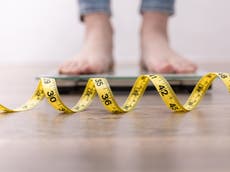The Independent's journalism is supported by our readers. When you purchase through links on our site, we may earn commission.
What is ‘Ozempic face’? Doctors warn about facial ageing side effect of diabetes medications
“Weight loss may turn back your biological age, but it tends to turn your facial clock forward,” one dermatologist says
Your support helps us to tell the story
From reproductive rights to climate change to Big Tech, The Independent is on the ground when the story is developing. Whether it's investigating the financials of Elon Musk's pro-Trump PAC or producing our latest documentary, 'The A Word', which shines a light on the American women fighting for reproductive rights, we know how important it is to parse out the facts from the messaging.
At such a critical moment in US history, we need reporters on the ground. Your donation allows us to keep sending journalists to speak to both sides of the story.
The Independent is trusted by Americans across the entire political spectrum. And unlike many other quality news outlets, we choose not to lock Americans out of our reporting and analysis with paywalls. We believe quality journalism should be available to everyone, paid for by those who can afford it.
Your support makes all the difference.Doctors are warning individuals who have turned to diabetes medications to lose weight that the drugs may result in unwanted side effects such as facial ageing.
In recent months, injectable prescription medications such as Ozempic and Mounjaro, which were created for those with type 2 diabetes, have seen a rise in popularity among individuals who view the drugs as a quick-fix weight-loss method.
Social media, and reports of widespread use of the drugs among celebrities, have contributed to the phenomenon, which since has resulted in shortages of the prescription medications.
However, doctors have now issued a warning about “Ozempic face,” a possible side effect of using the drugs both as a weight-loss method and without the proper medical supervision, as users have shared their experiences with accelerated ageing.
Jennifer Berger, 41, told The New York Times in January that she began injecting Mounjaro, a brand name for tirzepatide, to lose weight after her pregnancy. Although the medication helped Berger lose 20 pounds over three months, she said it also left her almost unable to recognise her face in the mirror.
“I remember looking in the mirror, and it was almost like I didn’t even recognise myself,” she told the outlet. “My body looked great, but my face looked exhausted and old.”
The side effect is one that Dr Paul Jarrod Frank, a dermatologist in New York who spoke to The New York Times, has coined “Ozempic face,” and he claims he’s begun seeing it in his office “every day”.
“A 50-year-old patient will come in, and suddenly, she’s super-skinny and needs filler, which she never needed before. I look at her and say: ‘How long have you been on Ozempic?’ And I’m right 100 per cent of the time,” he said, adding: “It’s the drug of choice these days for the one per cent.”
Dr Frank, who likened the popularity of the drugs to erectile dysfunction treatment Viagra, is not the only one who has witnessed the influx in patients seeking treatment for the side effect. Dr Dhaval Bhanusali, a dermatologist in New York, also told The New York Times that he’s seen an increase in patients on the medications who are “concerned about facial ageing and sagging”.
“We are seeing more and more patients on the medications coming in,” he said. “Generally, it’s people in their 40s and 50s who are losing significant amounts of weight and are concerned about facial ageing and sagging that occurs as a result.”
New York-based plastic surgeon Dr Oren Tepper, who also spoke to the newspaper, said the increase in “Ozempic face” is not surprising and noted that weight loss often leads to a more aged appearance as “key areas of the face” deflate.
“When it comes to facial ageing, fat is typically more friend than foe,” he explained. “Weight loss may turn back your biological age, but it tends to turn your facial clock forward.”
As for whether the side effect can be reversed, the dermatologists said the only way to do so in a noninvasive way is through the injection of fillers, which can cost thousands of dollars.
Though, Dr Tepper says, when a significant amount of weight is lost rapidly, fillers may not be enough to restore lost volume in the face. At that point, he said plastic surgery becomes “the only way to restore the volume loss”.
He said individuals using the drugs to lose weight often do not realise the impact it will have on their face, and that, for many, the sudden weight loss is like “winning a lottery Mega Millions”.
“But then they realise there’s a tax that comes with it - the loss of fat in the face - so it may not be quite the windfall they imagined,” he said.
The plastic surgeon told the newspaper that he treats “Ozempic face” with a deep plane face-lift, which costs $75,000, and a procedure that transfers fat from other parts of the body to the face, which can cost an additional $12,000.
As interest in the diabetes medications for weight loss continues to grow on social media, doctors have taken to platforms such as TikTok to share advice on combating the ageing effects.
In one TikTok posted by Dr Rocio Salas-Whalen, who also spoke to The New York Times, the endocrinologist in New York says users can prevent “loose and sagging skin” during weight loss by losing weight gradually, staying hydrated, avoiding smoking, and increasing protein intake, which she noted is “basic for the production of elastin and collagen.”
However, according to Dr Joshua Zeichner, a board-certified dermatologist and director of cosmetic and clinical research in dermatology at Mount Sinai Hospital in New York City, who spoke to The Independent, “weight loss, whether it is from diet, exercise, surgery, or a medication, takes toll on your face”.
“Fat in the face helps us maintain a naturally youthful appearance,” he explained, adding: “When you lose facial fat, the face often appears gaunt and skeletonised” and that the face can appear “significantly older” in those who lose large amounts of weight.
In addition to injectable fillers, Dr Zeichner said treatments such as “microneedling with radiofrequency, or a variety of other devices,” can help tighten the skin and improve skin laxity. He also noted that, in “severe cases, surgical corrections like a facelift might be an appropriate solution”.
Facial ageing is not the only concern individuals using the medications have to be aware of either. The prescription drugs can also lead to other, potentially dangerous side effects.
In a press release from the US Food and Drug Administration (FDA) announcing the approval of Wegovy, a brand name for semaglutide and treatment for chronic weight management, it notes that the most common side effects include nausea, diarrhoea, vomiting, constipation, abdominal pain, headache, fatigue, indigestion, dizziness, and digestive disorders.
The FDA also warns about more serious complications that can arise from use of the medication, such as the “potential risk of thyroid C-cell tumours,” pancreatitis, gallbladder problems, acute kidney injury, increased heart rate and suicidal behaviour or thinking.
According to the website for Ozempic, which is not FDA-approved for weight loss, the potential serious side effects are similar to Wegovy’s. The website warns patients about possible thyroid tumours, including cancer, pancreatitis, changes in vision, and kidney and gallbladder problems.
The most common side effects experienced by individuals using Mounjaro include nausea, diarrhoea, vomiting, constipation, indigestion and stomach pain, while the website also warns Mounjaro “may cause tumours in the thyroid, including thyroid cancer,” gallbladder or kidney problems, changes in vision and pancreatitis.
In addition to countless posts praising the drugs as a magic weight-loss method, users have also taken to social media to share their experiences with the various side effects.
One TikTok user says they have experienced nausea after taking Mounjaro, while another user said they suffered from acid reflux while taking Ozempic.
Dr Salas-Whale, who described Mounjaro as the “Apple 14” of the diabetes drugs, says the side effects are “extremely rare if the medication is being prescribed at the right dose and with careful medical supervision”.




Join our commenting forum
Join thought-provoking conversations, follow other Independent readers and see their replies
Comments